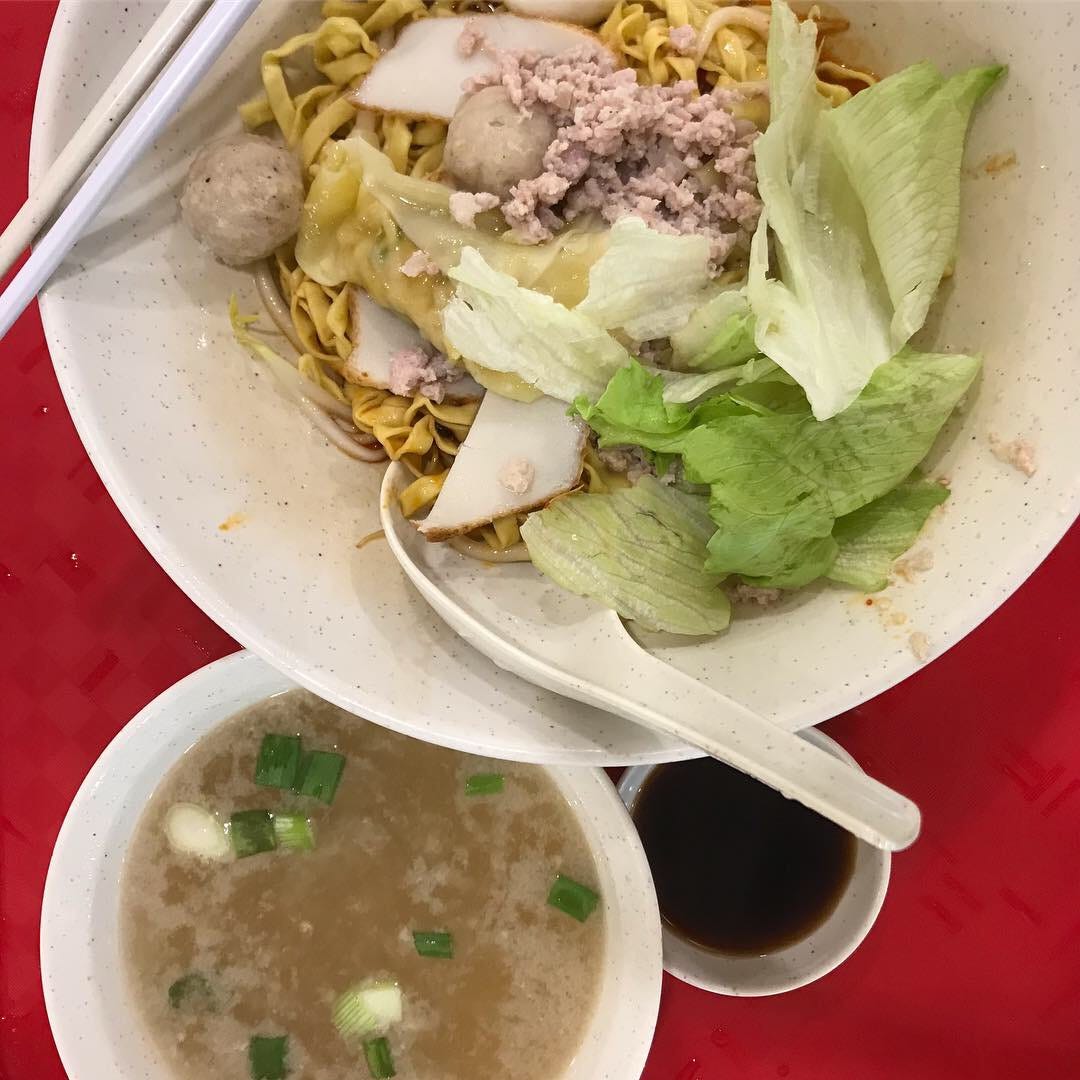The local noodle vernacular
An extra special thank you to my friend Vaughn for the loan of the phrase “the local noodle vernacular.” I miss his blog, which he no longer updates, but you can find his original use of the phrase here.
I grew up in Singapore, so it was inevitable that I’d eventually get round to writing about hawker food. I’ll start with something I eat nearly every day when I’m in Singapore.

You order this dish by going up to a noodle seller and asking for mee pok tah - dry noodles. (In Singapore any noodles that don’t come in soup are referred to as dry, though they’re invariably sauced, sometimes quite heavily.)
Everything about this dish feels more humble than it is. The name is generic, the presentation careless. Even the stalls are quiet and unspectacular, with no clanging woks, charcoal smoke, or giant griddles hissing. The only piece of equipment is a noodle boiler with three compartments. One compartment contains broth, one contains fishballs poaching in hot water, and one is for boiling noodles. There’s an array of sauces in crocks, a case of raw ingredients, and heaps of noodles on a counter.
Most stalls have several types of noodles piled next to each other, as there is technically a choice of noodles, but the classic, and in my eyes the only legitimate one, is mee pok. Mee pok looks almost exactly like fresh fettuccine, but frizzy. Its yellow color comes not from egg yolks, but the potassium bicarbonate used to alkalize the dough and add chew. The dressing always contains rendered lard, light soy sauce, and black vinegar. If you ask for it spicy, as I do, the hawker add sambal, which colors the sauce rust red. Sometimes there is ketchup, a distasteful but not entirely newfangled addition. The photo shows the canonical toppings: shiitake mushrooms braised in soy, a few slices of fish cake, sometimes a fishball or two, usually the grey marble of a meatball. The white nubs are minced pork, the grey slices pork liver. A scrap of torn lettuce and some fragments of dried sole (铁脯) to finish. Some broth goes in a separate bowl. The whole thing is done in under 3 minutes, with absolutely no ceremony.
I don’t know if I have made this dish sound lavish or spare, but I have never paid more than US$3.50 for a bowl. You can’t sell it for more.*



This is every bowl of noodles from my last trip home. The variation is clear, but it’s not like these are from different schools of mee pok tah, the way you have schools of kung fu, or regional ramen styles. Every bowl summarizes an individual hawker’s choices about how to make a dish so basic it barely has a name. Today these choices are mostly about what to omit in as costs rise and prices don’t.
Here is a list of toppings left off at least one of the bowls pictured: mushrooms (critical to the identity of the dish), liver (equally critical), dried sole (also critical, though less visible), croutons of rendered fatback (traditional but not actually a defining feature). Though the bowl of broth can’t be seen in most of these photos, all but one were missing the traditional garnishes of tang chye (bok choy, salted and dried until it’s almost bok choy jerky) and alaria. Serious eaters would say the things that really make the dish can’t be photographed: the character of the sambal, the ritual of having the hawker tailor your sauce, and most importantly, the precision of the noodle cookery. Yet because the dish classically includes this multitude of grace notes, it offers hawkers a lot of corners to cut. Mee pok tah has become a particularly visible record of how hawker food is quietly, magically, shrinking.
Some of this is due to tastes changing. Many people, especially younger customers, ask for the liver to be omitted. Without the demand there’s little reason to keep a perishable ingredient around, especially since it’s no longer given away for free, as it frequently was until the 90s. The same thing happened to the croutons of fatback. Once people stopped insisting on them, there was no reason for a hawker to render their own lard when they could buy rendered lard by the 17-kilo tin.
But a lot of the shrinkage happened because hawkers cannot afford to keep everything on the plate that was once there; and because fewer and fewer people know what the dish once was. I’m not against hawker food changing - it’s counterproductive to try to preserve a vital, living idiom in amber. But I think it’s important to ask whether the forces driving change are desirable, and whether the changes weaken or strengthen hawker culture as a whole.
*I should qualify this by saying that people do sell it for more, by tricking the bowl out with ingredients like fresh scallops or shrimp, but this, like adding truffles to a hamburger, just makes everyone involved look bad.
Have a video of human beings this week, in this case, a video of hawker making mee pok tah, with introductory dialog that does a passable imitation of David Mamet.*
Why I quit ordering from Uber-for-food startups, an old-but-new-to-me piece about delivery startups now long dead, but one that actually had something optimistic to say. Of course, the model that was better for human beings is the one that no longer exists.
Thank you for reading let them eat cake, a weekly newsletter about food systems and food. And as always, a super-special thank you to my pre-release readers, Jen Thompson and Diana Kudayarova.
best,
tw
p.s. I’d love to buy you a coffee. Drop me a line!


